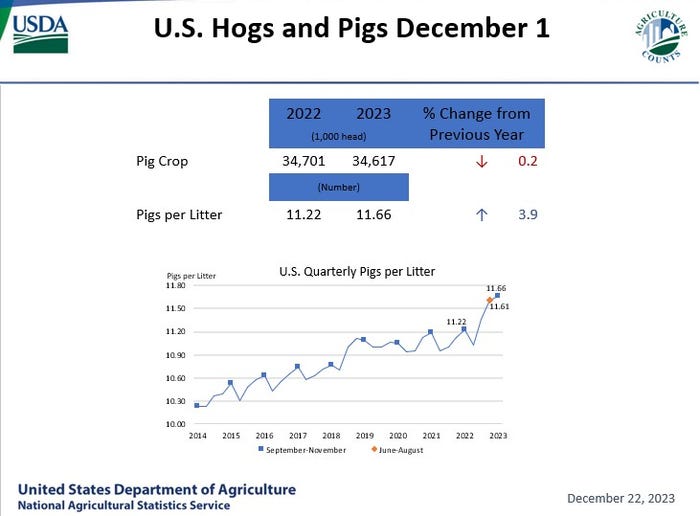U.S. hog and pig inventory up slightly, now 75 million head
Analysts see surprising figures in breeding inventory, 180-pounds-and-over and pigs saved per litter.

As of Dec. 1, there were 75 million hogs and pigs across U.S. swine production systems. According to the latest Quarterly Hogs and Pigs report by the USDA's National Agricultural Statistics Service, the Q4 inventory came in just a trace above last year’s supply but was down from last quarter’s report, after revisions increased the September 2023 hogs and pigs inventory by 1.4%.
The first big surprise from the December report notes Lee Schulz, associate professor in the Department of Economics at Iowa State University, was the kept for breeding category, at 6 million head. That figure was a 3% drop from last year, as well as a 3% reduction from the previous quarter.
“Pre-report estimates had it down 1.3% compared to a year ago and it came in at a much larger decline than that, at 3.3%. So, there was a two-percentage point difference between what analysts expected and what the report showed,” Schulz says. “Now, I think as we've looked at the economic situation that producers have been facing, looked at some of the sow slaughter levels, I think there was a notable possibility or expectations that we were going to see a larger decline year-over-year in that breeding herd.”
Market hog inventory totaled 69 million head, a marginal increase from last year, but a small reduction from the previous quarter.
For the under-50-pounds weight category, there were 21.681 million head, down slightly from the year prior. In the 50-to-119 pounds group, there were 19.039 million head, a slim decline from 2022.
In the 120-to-179-pounds group, there were 14.908 million head, up 1% from last year at this time. Finally, for the 180-and-over group there were 13.344 million head, up 2% from 2022.
Schulz says market hog inventory numbers were mostly in line with pre-report expectations, except for the 180-pounds-and-over category, which was much larger.
“For the first three weeks of December, slaughter's been up 3.8%, and so it was fully expected that we're going to see a larger inventory of 180 pounds and over. A lot of those hogs have been slaughtered already. Since September, we've actually been up 2.2%, compared to what the Hogs and Pigs report had, about 0.6%,” Schulz says. “So, when USDA did go make some of the revisions, some of those were to those slaughter levels to account for the bigger slaughter that we've seen since September.”
Between September 2023 and November 2023, 34.6 million pigs were weaned on U.S. farms, down slightly from 2022. Sows farrowing during this period totaled 2.97 million head, a 4% drop from 2022.
From September 2023 through November 2023, U.S. hog and pig producers saved an average 11.66 pigs per litter, compared to 11.22 last year. The NASS noted this is the fifth consecutive quarter for improved efficiency in U.S. sows.

USDA
“When we look at that number, you know, it was up 3.9%, 0.8% higher than the pre-report expectations,” Schulz says. “But what that caused is a much larger increase in the pig crop relative to pre-report expectation. So, pig crop was slightly below year ago levels, but that was driven by the much lower sows farrowed, 4% lower, but then the much larger increase in productivity.”
United States hog producers intend to have 2.9 million sows farrow during the December 2023-February 2024 quarter, a 2% drop from actual farrowings during the same period one year prior, and a 1% dip from two years prior. Intended farrowings for March-May 2024, at 2.91 million sows, are down 1% from the previous year and down 2% from two years earlier.
Iowa hog producers accounted for the largest inventory among the states at 24.9 million head. Minnesota had the second largest inventory at 9.1 million head. North Carolina was third with 7.8 million head.
The total number of hogs under contract owned by operations with over 5,000 head, but raised by contractees, accounted for 51% of the total United States hog inventory, up 3% from the previous year.
Revisions
The September revision was not the only adjustment made to previous reports, as Schulz states the report had several notable revisions.
“So, as analysts look at a lot of these numbers, it's going to take us a little bit longer, I think to really analyze these, because one, they're due to the changes we currently see in inventory numbers, but also where USDA went back in and adjusted some of the numbers, given what they had seen with slaughter levels, export levels, and the balance sheet approach that they took,” Schulz says. “Now that's important that USDA goes and does that, so we true up those numbers, but given that, we need to take that into consideration when we interpret the Hogs and Pigs report.”
A revision of 1.1% was made to the June-August 2023 pig crop. The net revision made to June 2023 all hogs and pigs inventory was 1.6%. A net revision of 1.6% was also made to the March-May 2023 pig crop.
The net revision to the March 2023 all hogs and pigs inventory was 1.7% while December 2022 all hogs and pigs inventory saw a 2.5% modification and September 2022 all hogs and pigs inventory a 1% change. A revision of 2.2% was made to the June-August 2022 pig crop. Finally, the net revision made to June 2022 all hogs and pigs inventory was 0.2%., while March 2022 all hogs and pigs inventory saw a 1.4% adjustment.
All inventory and pig crop estimates for December 2021 through September 2023 were reviewed using final pig crop, official slaughter, death loss, and updated import and export data.
To obtain an accurate measurement of the U.S. swine industry, NASS surveyed 6,341 operators across the nation during the first half of December.
About the Author(s)
You May Also Like





